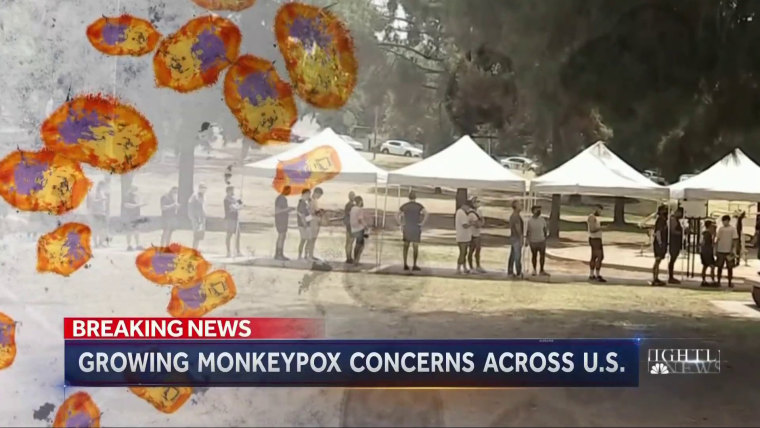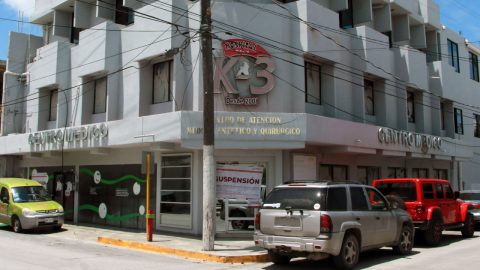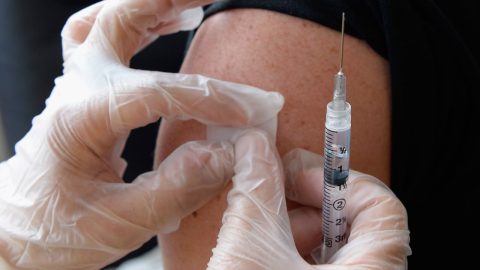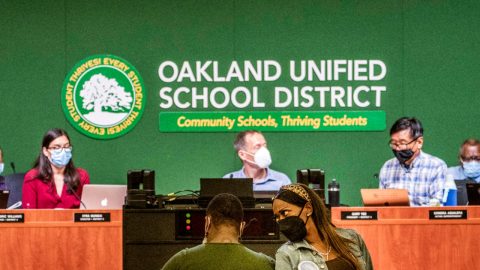Misinformation about the monkeypox outbreak is spawning an epidemic of largely unfounded anxiety, experts say.
Nearly 1 in 5 people in the U.S. are worried they will contract monkeypox, according to a recent survey by the Annenberg Public Policy Center. Almost one-quarter of women in the survey said they were worried about contracting monkeypox, even though almost all of the 11,177 cases in the U.S. are in men.
“You don’t want to send a message that this will only affect gay men,” said Dr. Tom Frieden, former director of the Centers for Disease Control and Prevention who is now president and CEO of Resolve to Save Lives, a global public health initiative. Nevertheless, the virus is “primarily, overwhelmingly a disease of men who have sex with men, spread through sexual contact.”
“I’m startled at the number of people who I know in the U.S. and globally who, when I mention this, are shocked as if they’d never heard that before,” he said.
Rampant spread of misinformation online is to blame for the disproportionately high anxiety, experts say.
In May, a group of South American researchers analyzed the top English-language Twitter traffic regarding monkeypox. They found that half of it was misinformation or unverifiable information; just 28% included serious, factual information.
Misleading tweets edged out the others in replies and retweets, according to a letter published in The Journal of Infection in Developing Countries on July 28.
Since the World Health Organization declared monkeypox a global health emergency in July, unfounded claims about who is at risk and how the virus is transmitted have escalated. Last week, WHO officials urged the public to stop attacking monkeys after reports surfaced of primates being poisoned and killed.
In interviews with NBC News, epidemiologists and infectious disease experts dispelled some of the most common misconceptions, including whether the virus spreads easily through the air, that cases among women and children are being undercounted, and that health care workers are at high risk.
For starters, there is no strong evidence at this time that health care workers are at substantial risk of contracting monkeypox on the job. While 386 health care professionals have been diagnosed with the virus worldwide, most contracted the virus in the community, according to the WHO. The agency said more investigation is needed on the matter, however.
Are cases in women and children being missed?
A persistent misconception is that cases among women and children are going undiagnosed because they aren’t being tested.
While there have been a small number of pediatric cases, there’s no evidence of sustained transmission, according to numerous national and regional health agencies.
Dawn O’Connell, the assistant secretary for preparedness and response at the U.S. Department of Health and Human Services, said on a call with reporters in July that monkeypox testing was being conducted outside of gay and bisexual men, “and we’re not seeing many positives.”
On Aug. 10, North Carolina health authorities reported that 30 women have been tested for monkeypox in the state. None had the virus.
Reports on the outbreak from the United Kingdom Health Security Agency also refute that substantial cases in women have gone undiagnosed. In the U.K., the test-positivity rate in men is about 50%, compared with 2% among women and less than 1% among children. A recent report from the agency indicated that the vast difference between men’s and women’s test-positivity rates has remained consistent for months
Throughout the 2022 outbreak, official reports from national and regional health authorities and the WHO, as well as a number of peer-reviewed published papers, have consistently found that monkeypox is overwhelmingly transmitting via sexual contact between men.
An Aug. 5 CDC report found that, through July 22, 99% of cases were among men, 94% of whom reported recent sexual contact with males. WHO has reported that 98.7% of confirmed cases globally are in males. Of the cases with information about sexual partners, 97.2% are in men who have sex with men.
On July 26, an international group of researchers released a report projecting that men who have sex with men would remain the only high-risk group for monkeypox infection in the current multi-country outbreak. The virus would be much more likely to hit transmission dead-ends in other groups, the scientists wrote. The paper is a preprint and has not yet been peer-reviewed.
Monkeypox is not caused by Covid vaccines
Claims linking monkeypox and Covid vaccines are “so crazy and wrong,” said Dr. Alfonso J. Rodriguez-Morales, lead author of the Twitter misinformation study and infectious diseases professor at the Faculty of Medicine at the Fundación Universitaria Autónoma de las Américas in Colombia.
The monkeypox virus was first identified in humans in 1970 and has since become endemic in 11 nations in western and central Africa. The 2022 outbreak began as early as April in the U.K.
Does monkeypox spread easily on surfaces, in the air, even from food?
On Twitter, the hashtag #MonkeypoxIsAirborne has gained traction. An internet rumor held that someone in Spain contracted the virus through contaminated handle bars on a scooter. Other online musings suggest that even food can transmit the virus or that toilet seats will become a major source of transmission.
A preprint paper released Jun 30 showed that high concentrations of virus could be found on hospital room surfaces after they were inhabited by people with monkeypox.
And viable monkeypox samples were found on surfaces in the household of an individual who had the virus and had vacated the premises 15 days prior, according to a recent CDC report.
But whether virus exists in a particular location and whether it will then readily infect a person are two different things, experts stress.
“We know that it’s possible for monkeypox to spread via contaminated surfaces,” said Anne Rimoin, an epidemiologist at the UCLA Fielding School of Public Health and a leading monkeypox expert. This includes, in particular, bedding, sheets, towels and unwashed clothing that has come into contact with infected lesions.
“Is that going to be a common source of transmission?” Rimoin said. “Probably not, but it’s certainly possible.”
The virus can also transmit through respiratory droplets during prolonged face-to-face contact.
Two recent peer-reviewed studies provide important insights into how likely such transmission routes really are.
The first paper, published July 21 in The New England Journal of Medicine, documented a pool of 528 global cases. The study estimated that 95% of the cases stemmed from sexual close contact between men. Just 0.8% were likely due to nonsexual close contact and 0.6% were due to household contact.
“We know that the virus exists on surfaces, and we know that it can be transmitted to household contacts, but that these are very limited chains of transmission,” said Dr. Chloe Orkin, an infectious disease expert at Queen Mary University of London and the paper’s lead author.
The prospect of monkeypox “exploding in other communities through contact with infected surfaces,” Orkin added, “is very unlikely, because the clear route of transmission is through sexual contact.”
In an Aug. 8 study in The Lancet of 181 monkeypox cases in Spain, swabs of lesions contained approximately 1,000 times greater level of virus than swabs taken from the mouth and throat of infected people.
While this finding “cannot directly respond to the question of the likelihood of aerosol transmission” of monkeypox, “what we can say is that skin lesions are much more infectious compared with respiratory droplets,” joint senior co-author, Dr. Oriol Mitjà, an associate professor in infectious disease at the University Hospital Germans Trias i Pujol, in Badalona, Spain, said in an email.
Only 3% of cases in the study likely derived from nonsexual household contact, Mitjà said.
Is monkeypox a sexually transmitted infection?
Researchers have found monkeypox in semen, but more research is needed to determine whether ejaculation itself can transmit the virus. Regardless, studies have suggested that both anal and oral sex are major conduits of transmission.
Monkeypox likely transmits most efficiently when lesions come into contact with mucus membranes, including in the genitals, anorectal areas, or the mouth and throat, Mitjà said. By comparison, healthy skin “is less efficient for transmission since mucous membranes are less protected against infection.”
While the general population isn’t currently at high risk for infection, cases could spread to other groups, “that have frequent skin-to-skin contact, such as children or adults who commonly suffer from skin-to-skin infection outbreaks,” Mitjà said.
Rimoin offered an additional caveat about monkeypox transmission risk. The more the virus spreads, the more times it will indeed transmit in “unlikely scenarios.”
“I think it’s very, very important for everyone to be cautious about making bold and definite statements about how this virus is only going to spread,” Rimoin said.










Recent Comments